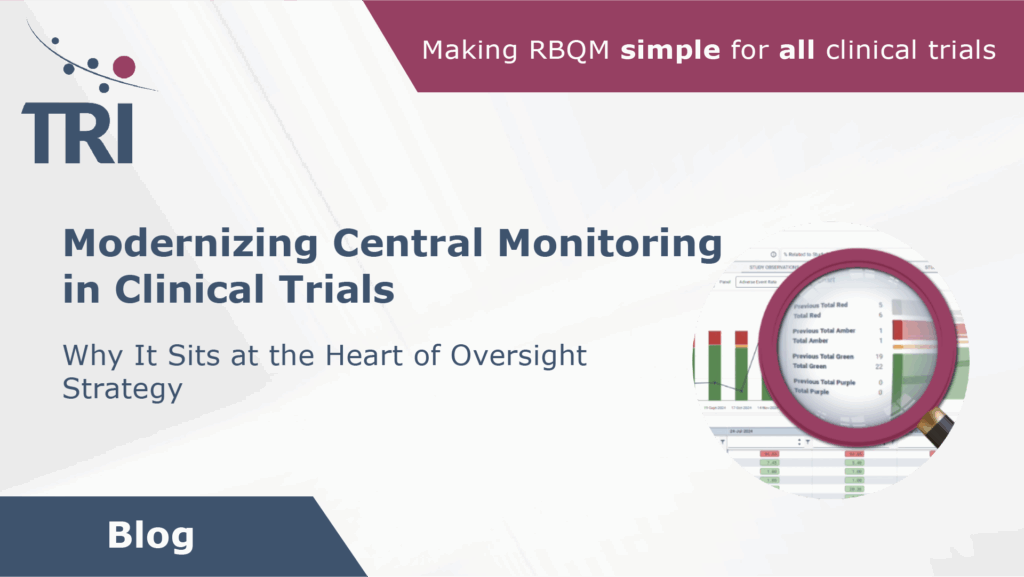Modernizing Central Monitoring in Clinical Trials

Why It Sits at the Heart of Oversight Strategy
Imagine a global trial with over 80 sites begins to show a spike in protocol deviations.
The sponsor only notices the trend after a quarterly monitoring visit. By that point, timelines have slipped, data queries are mounting, and site morale is faltering. Although fictional, this scenario reflects a very real vulnerability in traditional monitoring models, and it’s exactly the kind of issue ICH E6 (R3) is designed to prevent.
The release of ICH E6 (R3) in early 2025 offers a new blueprint for clinical oversight, redefining Good Clinical Practice. At the heart of this shift is central monitoring, now recognized as a strategic capability essential to trial success.
Central Monitoring Is Operationally Critical
ICH E6 (R3) makes it clear in Annex 1 that sponsors must implement monitoring strategies that are proportionate to the risks to participant safety and data integrity, and capable of adapting as the trial evolves.
This principle marks a shift away from rigid, one-size-fits-all oversight models toward more dynamic, fit-for-purpose approaches.
This is especially relevant in today’s data-rich environment. Trials now pull information from electronic health records, ePRO systems, wearables, and lab platforms. Without a centralized view, sponsors risk missing critical signals. Central monitoring enables real-time detection of trends, outliers, and site-level performance issues, long before they escalate into protocol deviations or safety concerns.
Designing Oversight Around What Matters Most
Quality by Design (QbD), now embedded in E6 (R3) , requires sponsors to identify Critical-to-Quality (CtQ) factors, those elements that, if compromised, would undermine participant safety or data reliability.
Rather than viewing CtQ identification as a formality, we position it as the foundation of our monitoring strategy. These factors are mapped to operational metrics and used to configure oversight tools. For example, when a trial’s primary endpoint relies on subjective assessments, statistical checks are implemented to detect inter-rater variability. If eligibility criteria are complex, inconsistencies in screening logs across sites are flagged and reviewed.
This approach ensures monitoring is both risk-based and clinically meaningful, directly supporting trial outcomes.
Risk-Based Monitoring: From Theory to Execution
RBM has been widely discussed, yet E6 (R3) gives it structure and regulatory weight.
Sponsors are now expected to document their risk assessment methodology, justify their monitoring decisions, and demonstrate continuous evaluation throughout the trial.
Long before E6 (R3) formalised these expectations, OPRA was already ahead of the curve. Designed to support adaptive oversight and real-time decision-making, OPRA integrates structured and unstructured data, applies intelligent algorithms to detect risk signals, and presents findings in a format that supports targeted action.
Instead of overwhelming teams with raw data, OPRA helps distinguish between noise and signal, allowing resources to be directed where they’re needed most.
Data Governance: Raising the Bar for Oversight
E6 (R3) introduces a more rigorous framework for data governance. Sponsors must ensure traceability, auditability, and integrity across all data systems.
This includes metadata management, version control, and validation of electronic platforms.
These expectations have expanded the responsibilities of central monitors and data scientists. Their role now includes oversight of data flow, reconciliation, and system validation, requiring not just technical fluency, but a deep understanding of clinical context and regulatory scrutiny.
To meet these demands, our operational model brings together expertise from central monitoring, QA, biostatistics, and clinical operations. This collaborative approach ensures that data governance is embedded across the trial lifecycle, rather than treated as a siloed or reactive function.
Smarter Systems for Smarter Monitoring
ICH E6 (R3) encourages the use of validated systems that support real-time monitoring, risk detection, and adaptive decision-making.
But not all technology is created equal.
OPRA was ahead of the curve, engineered to elevate the entire oversight process. The platform interprets data in context, distinguishing between isolated anomalies and systemic risks that could compromise trial integrity. It tracks site performance over time, correlates operational metrics with protocol compliance, and surfaces patterns that inform proactive decision-making.
One of OPRA’s key strengths is its ability to refine the focus of oversight. By intelligently prioritising what matters most, it reduces unnecessary queries and interventions, lightening the operational load on sites without compromising quality or safety.
From Gatekeeper to Strategic Partner
Under E6 (R3), Quality Assurance is no longer a retrospective function. QA must be engaged from the outset, helping to define CtQ factors, validate monitoring plans, and ensure that oversight mechanisms are risk-proportionate and fit for purpose.
OPRA makes this integration possible. Its architecture is built to support audit-ready documentation, traceable decision-making, and real-time visibility into protocol compliance. Every action is captured with context and aligned with regulatory expectations.
This is foundational to QA. OPRA enables sponsors to operationalise quality assurance in line with R3, making it a practical, embedded part of trial conduct rather than a post-hoc review.
Central Monitoring as a Competitive Advantage
Sponsors who embrace central monitoring as a strategic capability will be better positioned to deliver high-quality data, protect participants, and satisfy regulators.
This is the direction ICH E6 (R3) is pointing us toward.
What’s clear is that the future of clinical trials will be shaped by those who can interpret data with clarity and embed quality into every operational decision.
Central monitoring is the foundation of modern trial management, and OPRA is how we start building it.
